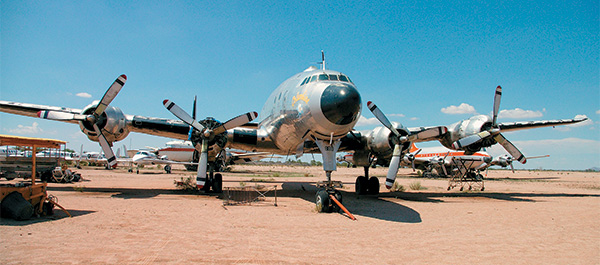
For almost a decade it has stood stoically in the Sonoran Desert of southern Arizona. Its name, Columbine, is faded, but the colors are still recognizable against the dusty aluminum. It’s tattered but still stands proud in memory as the first “Air Force One.”
Officially, this L-749 Constellation is the first aircraft to carry the coveted call sign. The name stems from a near midair collision in 1953 when the Constellation, identified by its registration number 8610, was mistaken by air traffic controllers for an Eastern Airlines flight with the same designation. After that mix-up the Air Force insisted that any aircraft carrying the U.S. president be identified as Air Force One.
Initially 8610 operated with the Military Air Transport Service, Atlantic Division, flying shuttles from New York to Iceland. In 1952 it was transferred to Burbank, Calif., and converted to a VC-121A. As a VIP transport, it was fitted with deluxe seating, a galley and other amenities. In 1953 President Dwight Eisenhower designated it as his official aircraft and had Columbine II emblazoned on the nose. (The columbine is the state flower of Colorado, Mamie Eisenhower’s home.) Eisenhower used Columbine II until 1959, when he traded it in for Columbine III, a VC-121E Super Constellation. In 1968 the old Connie ended up at Davis-Monthan Air Force Base, where it was retired.
According to Lockie Christler, he and a consortium of investors bought the airplane at auction in 1970 along with four other aircraft. At the time they did not know that 48-610 had been a presidential transport. After the sale, a landing gear parts mismatch kept the plane grounded. It was moved to a civilian airfield and for 20 years used for spare parts. In 1989 Christler family members and volunteers began restoration. The next year the aircraft was flown to the Dwight Eisenhower Centennial in Abilene, Kan., the president’s home. After some time on the airshow circuit, the Connie ended up in Santa Fe, N.M., where it languished for several years. In 1998 it was put up for auction in Scottsdale, Ariz., but never sold. In 2005 it went to Marana Regional Airport, where it has stood for nearly a decade.
Eisenhower’s granddaughter, Mary Jean Eisenhower, recently announced that the National Airline History Museum in Kansas City, Mo., is raising funds to buy Columbine II, move it to the museum and completely restore it. Plans call for the aircraft to be used for “Honor Flights” for veterans. A website for the effort, columbineii.org, is under development.




